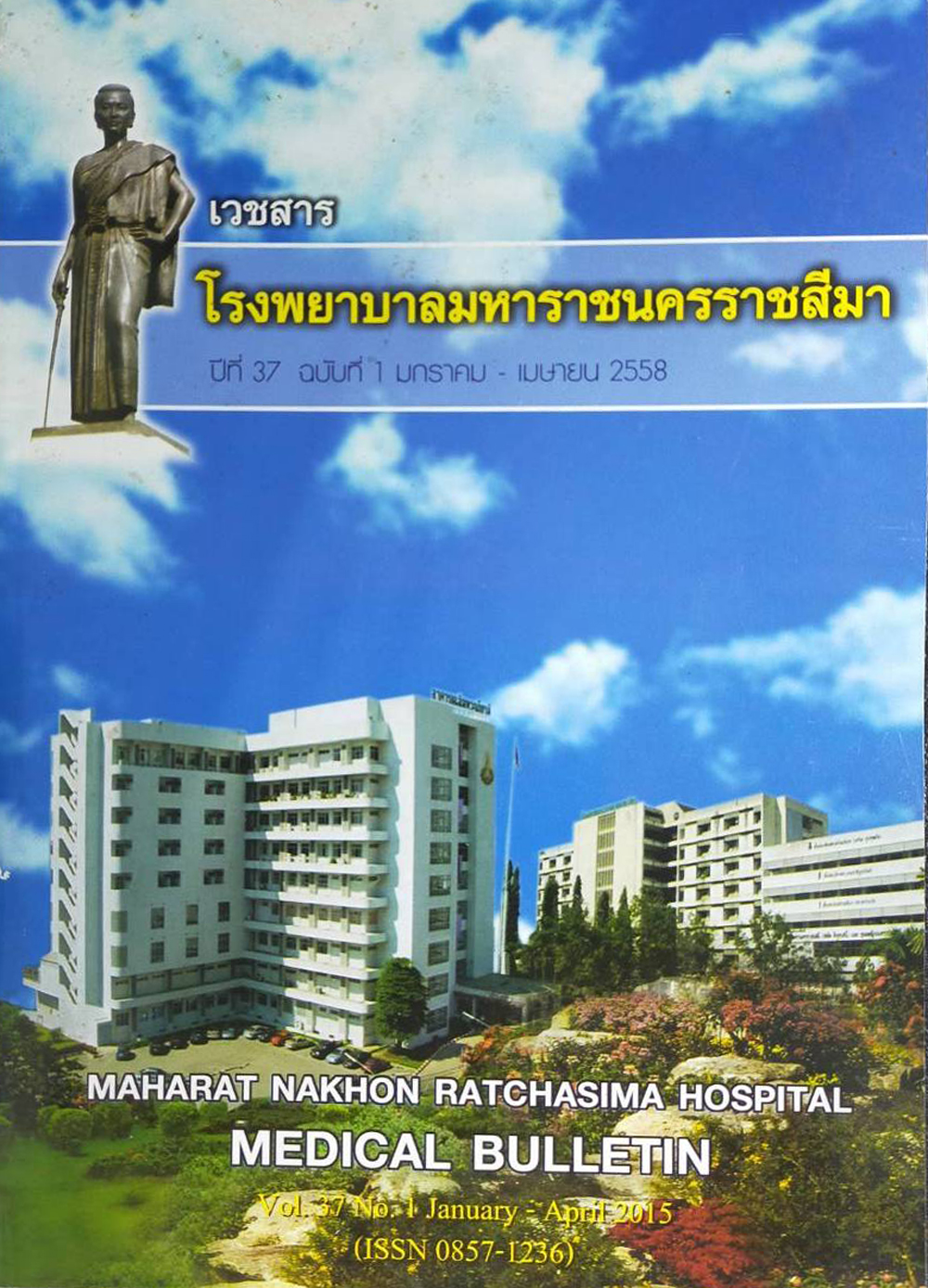โรคฮีโมโกลบิน เอช ที่ซ้ำเติมด้วย Autoimmune Hemolytic Anemia: รายงานผู้ป่วย 1 ราย
Main Article Content
บทคัดย่อ
Hematology Unit, Department of Medicine, Maharat Nakhon Ratchasima Hospital, Nakhon Ratchasima
52 เวชสารโรงพยาบาลมหาราชนครราชสีมา ปีที่ 37 ฉบับที่ 1 มกราคม - เมษายน 2558 โรค Hemoglobin H เป็นโรคที่ถ่ายทอดได้ทางพันธุกรรม อาการที่สำคัญคือ ภาวะโลหิตจางจากการที่เม็ดเลือดแดงแตกง่าย และ มีขนาดเล็กตั้งแต่เกิดการมีโลหิตจางซ้ำเติมด้วย autoimmune hemolytic anemia (AIHA) แบบในผู้ป่วยรายนี้ยังพบได้น้อยผู้ป่วยเป็นหญิง อายุ 20 ปี มาพบแพทย์ครั้งแรกด้วย โลหิตจางอย่างรุนแรงจากภาวะเม็ดเลือดแตกง่าย แต่ตับม้ามไม่โต, Hb 3.3 g%, Hct 11.6 %, MCV 98.6 fL, MCH 27.8 pg, NRBC 32/100 WBC, reticulocyte 19.4%, direct and indirect Coombs’ tests +2 จึงได้ให้การวินิจฉัยว่าเป็นภาวะเม็ดเลือดแดงแตกง่าย เข้าขั้นวิกฤตเนื่องจาก AIHA และให้การรักษาด้วย corticosteroid ต่อด้วย danazol, cyclophosphamide และ azathioprine เป็นลำดับ ผู้ป่วยตอบสนองต่อการรักษาไม่ดีเท่าที่ควรระดับ Hb แกว่งอยู่ระหว่าง 6.0 ถึง 9.2 g%, เฉลี่ย 7.6+1.6 g%, MCV 77.8+3.0 fL, MCH 22.0+1.3 pg ตรวจ Hbelectrophoresis พบ Hb A2AHBart และ ตรวจยีนส์ก็ยืนยันว่าผู้ป่วยเป็นโรค Hb H ตอนแรกธาลัสซีเมียถูกมองข้ามไปเพราะค่า MCV และ MCH อยู่ในเกณฑ์ปกติจนกระทั่งค่าความเข้มข้นของ Hb เพิ่มขึ้นมาบ้างหลังการรักษา AIHA แล้วค่า MCV และ MCH ที่ตํ่า ก็ปรากฏความจริง AIHA อาจจะมีความเกี่ยวข้องกับธาลัสซีเมียก็ได้ เพราะรูปร่างของเม็ดเลือดแดงในผู้ป่วย ธาลัสซีเมียมักเป็นแบบแปลก ๆ ขาดเป็นชิ้นส่วน ผิวเซลล์ที่อาจจะเปลี่ยนแปลงหรือมี alloantibody มาเกาะทำให้เกิด antigens ใหม่ และก่อปฏิกิริยาภูมิต่อต้านได้ ในที่สุดก็อาจก่อให้เกิด AIHA ได้อาจจะพอสรุปได้ว่าถ้าผู้ป่วย AIHA ตอบสนองต่อการรักษาด้วย steroid หรือ ยากดภูมิต้านทานอื่น ๆ ไม่ดีเท่าที่ควร อาจจะต้องนึกถึงธาลัสซีเมีย เช่น Hb H ด้วยโดยเฉพาะในรายที่ MCV ต่ำทีหลัง
Article Details

อนุญาตภายใต้เงื่อนไข Creative Commons Attribution-NonCommercial-NoDerivatives 4.0 International License.
เอกสารอ้างอิง
Chui DH, Fucharoen S, Chan V. Hemoglobin H disease: not necessarily a benign disorder. Blood 2003; 101: 791-800.
Fucharoen S, Viprakasit V. Hemoglobin H disease: clinical course and disease modifiers. Hematology Am Soc Hematol Educ Program 2009; 26-34. Doi: 10.1182/asheducation-2009.1.26.
Cividalli G, Sandier SG, Yatziv S, Engelhard D, Rachmi-lewitz N, Rachmilewitz EA. Beta-thalassemia compli-cated by autoimmune hemolytic anemia, globin synthesis during immunosuppressive therapy. ActaHaematol 1980; 63: 37-43.
Xu LH, Fang JP, Weng WJ, Huang K, Zhang YT. Autoimmune hemolytic anemia in patients with beta thalas-semia major.PediatrHematolOncol 2012; 29: 235-40.
Pachinburavan M, Marik PE. Bovine blood and neuromuscular paralysis as a bridge to recovery in a patient with severe autoimmune hemolytic anemia. ClinTranslSci 2008; 1: 172-3.
Singer ST, Wu V, Mignacca R, Kuypers FA, Morel P, VichinskyEP. Alloimmunization and erythrocyte autoim-munization in transfusion-dependent thalassemia patients of predominantly Asian descent. Blood 2000; 96: 3360-73.
Nillakupt K, Nathalang O, Arnutti P, Jindadamrongwech S, Boonsiri T, Panichkul S, et al. Prevalence and hemato-logical parameters of thalassemia in Tha Kradarnsubdistrict Chachoengsao Province, Thailand. J Med Assoc Thai 2012; suppl 5: S124-32.
Insiripong S, Supattarobol T, Jetsrisuparb A. Comparison of hematocrit/hemoglobin ratios in subjects with alpha-thalassemia, with subjects having chronic kidney disease and normal subjects. Southeast Asian J Trop Med Public Health 2013;44:707-11.
Galanello R, Cao A. Alpha-thalassemia. Genetics Med 2011; 13: 83-8.
Bosma GC, Davisson MT, Ruetsch NR, Sweet HO, Schultz LD, Bosma MJ. The mouse mutation severe combined immune deficiency (scid) is on chromosome 16. Immunogenetics 1989; 29: 54-7.
Altinoz MA, Gedikoglu G, Deniz G. Beta thalassemia trait associated with autoimmune diseases: beta globin locus proximity to the immunity genes or role of hemorphins? ImmunopharmacolImmunotoxicol 2012; 34: 181-90.
Agarwal MB, Viswanathan C, Gupte SS, Desai NG, Vasandani D, Bhave AA. Anti-nuclear antibody positivity in multi-transfused thalassemia major.Indian Pediatr 1992; 29: 607-10.


